Kids want to solve real world problems! Wouldn’t you also rather design a solution for a real problem rather than a project for the sake of an assignment?
Under the “New” BC curriculum there is an emphasis on constructivism and inquiry-based learning which begs to be supported by design and building such as that offered by Tinkercad. By encouraging cross-curricular learning in a Makerspace environment, kids can grow their core competencies of critical thinking, problem solving, collaboarative learning, active listening, communication, & creative thinking, through project based inquiry.

Kevin and I are wondering how to carry our cold drink cans with us hands free when we are cycling or camping. Well let’s take a look at the process of brainstorming to design to fabrication to presentation and how this could look in an elementary or middle school classroom.
Here is a suggested process of introducing Tinkercad to your classroom—adapted from Instructables.com.

- Get to know Tools yourself (Tinkercad, +/- Fusion 360, +/- 3D printer)
- It will be easier to help students when they encounter difficulties if you know the program and have already worked them out.
- Set up classroom for tinkercad
- computers, 3D software, internet, +/- mice
- Other useful tools include Makerspace materials, such as clay, popsicle sticks, glue, toothpicks, pipe cleaners, string, recyclable products & blocks for prototyping designs and brainstorming.

- Move from a 2D lens to a 3D lens when looking at your curriculum
- Look for opportunities to enhance learning by linking curriculum topics to core competencies and ASDT curriculum through cross-curricular projects with problem solving and design components.
- Explore with students the tinkercad gallery or Thingiverse (sharing design files) to get started.
- Watch videos of Tinkercad enthusiasts.
- Collaborate with colleagues!
- If another educator has valuable experience in using Tinkercad, ask them to showcase their design knowledge once you’ve scaffolded the students with the necessary factual information.
- Use Makerspace time to expand cross-curricular projects and engage seamlessly with core-competencies. (see Alison Galloway St. Mike’s school)
- Start with a simple project. Don’t overthink it!
- Don’t write instructions, just co-create a rubric with students so they focus on their own creativity.
- Tinkercad features step-by-step no fail lessons such as: make a ruler & make a clock.
- If groups of students are designing their own board game then maybe only one student is working to make game pieces on tinkercad (while others make the board, writing instructions, etc…)
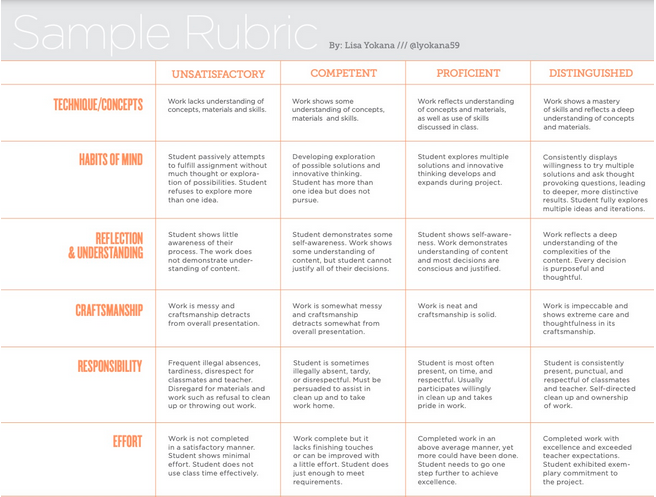
- Set up a Tinkercad virtual classroom—Tutorial.
- Invite students to join
- Assign projects
- Collects work for evidence of learning
- Suggestions for Tinkercad projects to get you started:
- Design your own game piece or key chain
- Design a board game
- Design a maze
- Map an ideal classroom
- Recreate a lost family memento as a gift
- Design and race balloon powered (vehicles?)
- Solve real world problems (related to science, social studies, or your biggest pet peeve, etc…)
- Check out the Tinkercad blog!

After tinkering is done, be sure to:

- Share student work
- Project presentations
- Idea bulletin board with their designs, or
- 3D printing for displays
- Assess
- Self assessments at each stage
- Drafts by stage (ideas, designs, prototypes, redesigns, final products)
- Cumulative product or display for summative assessment with a brief reflection on the process, the challenges, and what lessons were learned.
I can appreciate how the app scienceJournal can be implemented in place-based science learning in intermediate and middle school classrooms to augment learning of sensory information such as sound, motion, & light. I am drawn to the Sound safari exploration as I believe it would be perfect for grade 4/5 as it links to human anatomy in the BC science curriculum. It provides cross curricular learning in tech, science, math (graphs, comparing values. etc..), as well as supporting the development of various core competencies such as collaborative learning, planning, & critical thinking. A few drawbacks are availability of tech, safety of the tech being taken on a walk, and teacher familiarity with the program.
Joanna Lake gave a great lecture on using tech in the classroom which went from using tech for assessment, including doing mood scales at the start of the day as seen below with answers recorded on flip grid I think (Where’s Nutmeg?) to helping students stay on track with daily agenda reminders (see below).
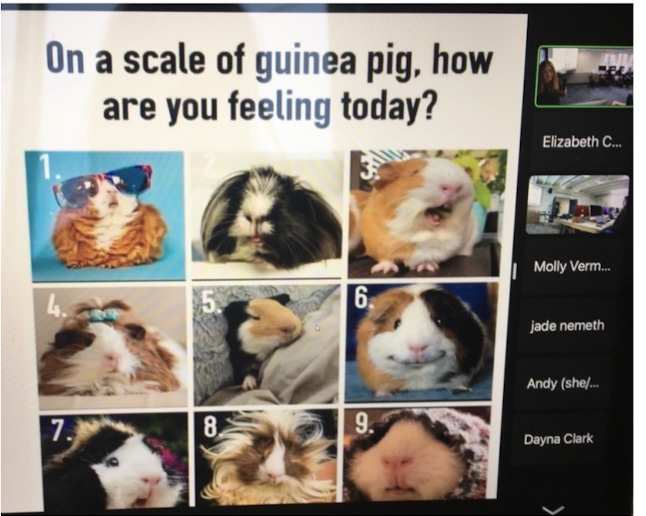

List of ways to use tech in the classroom to augment learning as suggested by Joanna Lake:
- mood scales
- feel good Fridays (write each other notes)
- memes
- start the day with watching a funny video
- joke of the day
- take attendance with “would you rather”
- class playlist
- visual schedules
- co-creating rubrics
- student video entries for projects on flip grid
- side by side text writing with mentor text available
- digital portfolios
Many of these suggestions help build community and trust in the classroom as well as acting as forms of tangible assessment.
I think I will try tech as my first morning communication with the class as they get settled and see how it goes. Flipgrid sounds cool and allows for inclusion of diverse learners.
Well, with all the rusty nib business it’s been awhile since I’ve practiced the calligraphy writing so I planned ahead and brought calligraphy paper, ink, and nibs on our family weekend away, OOOps! Scrunched paper….CLASSIC.
My goal at the start of this inquiry was to be able to write fancy Mom love notes to my kids. P.S. They are a great audience as they still think some of the things I do are Amazing!
So, I realize that I need many more hours practice to get the thin and thick lines consistent within words. Anyhoo…Here’s what I’ve got so far

Thecrookedcalligraphy website has free traceable calligraphy practice sheets to help beginners practice various strokes and words. There’s even one that helps you to regulate your breathing so that your thin upstrokes and thick downstrokes improve. Sounds like a 2 fur 1: calligraphy and meditation!!!Think I might try that.
So, I found this video on calligraphy meditation and it must be relaxing cause it’s 5 minutes of sleep inducing boredom. I’m pleased to be able to share it with you here. I think they are writing on kleenex in case you need to wipe the tears of boredom from your eyes.
So the above love notes will go on the kids’ pillows tonight so they know how much they are loved.
‘Till next time…
Multi-Access learning defines 4 levels of access:
- face-to-face
- synchronous online
- asynchronous online
- open access
But, can also integrate blended designs. It is important to note that the Multi-Access learning model developed in 2006 by Valerie Irvine, goes far beyond modality access. There are different ways to deliver multi access learning including:
- Hyflex
- Blended Synchronous
- Synchronous hybrid
How these are implemented is based on the class and access to resources/tech as well as teacher preference. Decisions around how to use the online component are made as teachers consider their pedagogical approach and choose between:
- Flexible learning
- Flipped learning (content is learned before class through recordings and other resources)
- Inquiry-based learning (creating time and space for independent learning)
There are pros and cons to all types of learning such as access, available time to prep, multilevel learners and familiarity with technology. It seems that that the hyflex model provides 4 different ways to interact with coursework so likely with satisfy most learners’ needs but can still be labour intensive for the teacher. Flipped learning may work well as an in class solution to a diverse learning needs classroom so that some students can work more independently or at a different pace than others who may need more teacher support. Videos can be watched then have learning stations set up to engage in active collaborative problem solving and project work. A concern for elementary online teaching is being able to keep the students engaged so I think synchronous learning with active participation would be the best option for k-5 if classes need to go exclusively online again in future.
Tinkercad

The moment you have all been waiting for………
DID THE RUSTY NIB SURVIVE?

So I followed the recommendation from moonandtide by scrubbing with an old toothbrush with baking soda and a bit of water.

Here it is…THE REVEAL……
I was hoping for some sparkles but what I got was a damaged nib but free from red rust so hopefully I have arrested (ha ha) the process of degradation.

More importantly…Does it still work?
Will it make my calligraphy Sparkle?
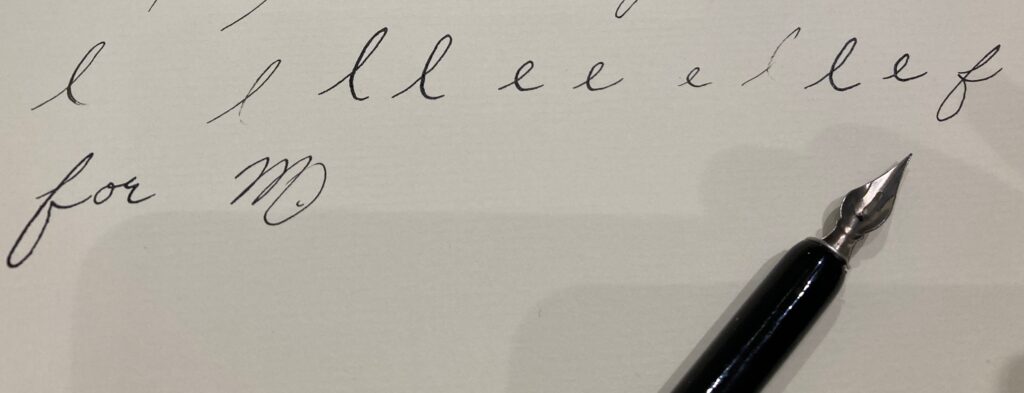
What do you think?
Hey….Be nice
Sorry folks you’re going to have to wait till next week to find out the fate of the poor rusty nib… I know I can hear your groans and whimpering….Sorry But…
As it turns out I had to devote myself to some family time and cuddle time with furry little cuties in order to restore some balance. And everyone loves a celebrity, so here she is: Nutmeg!!!!!!!


A huge shout out to Guinea Pig Owner and Trainer Extraordinaire Kylee. Check out Her Adventures with nutmeg here. Thank you so much for inviting us to spend time with these cuties. Also praises for my calm kids who were so respectful to these cute little creatures.
Onto a little tech now. I created an animated video last semester using powtoon for my inquiry on restitution as an approach to discipline in education. It was a steep steep steep learning curve and I’m glad I got some help from Coleen. It’s actually pretty user friendly once you get into it but as in any free app like that you are limited on the free templates but see what I was able to do for free. Here it is:
Scratch Dance Party
My grade four aged kids Love coding with Scratch Dance Party. Coding & computational thinking is a great way to:
- Develop problem solving skills as students try to get their dancers to change dance moves with the music they choose
- help explain the world & make virtual worlds come alive for example with VR tours of museums
- Have fun with grade curriculum through games such as geometry etc..
- Practice thinking & writting in more detailed and specific formats and practice problem solving and editing as exampled by the PB & J video.
Computational thinking can help learners become better problem solver’s because they must engage in the four steps of decomposition, pattern recognition, abstraction, and algorithm design. Decomposition involves breaking problems down into easier to manage pieces which is often the first step in creative problem solving. Pattern recognition is about recognizing whether you’ve used strategies in the past to solve problems and then building on those strategies to address current problems. Abstraction is an essential part of computational thinking and problem-solving because it allows you to remove extraneous information and focus exclusively on the details of the problem. It’s sort of a summary of which next steps need to be completed in order to solve the problem so it’s kind of about putting the pieces back together and summarizing the problem results after you have deconstructed to actually engage in the problem-solving practice. These are the same strategies necessary to create an infographic that is a summary of multiple and larger concepts which seems to be an essential skill of the 21st-century. Being able to focus and highlight important information out of textbooks and readings or videos is another important skill that is fostered through computational thinking in the educational setting. Think… CORE COMPETENCIES teacher candidates…Nailed it !
BUT remember… It’s not all dance parties and flappy birds (It’s not all peanut butter and gumballs) (It’s not all sunshine & rainbows)
- Screentime??
- internet & computer access
- kids playing that weird car game during class up in R hand corner of screen
- more difficult fo r me to see how to relate it directly to First Peoples Principles of Learning
- Not as conducive to early French Immersion classes as there is an expectation for no English.
I Coded a Flappy Bird Game! Wanna PLAY???
See how fun it can be to code and engage with creating games, videos and presentations using scratch type coding programs.
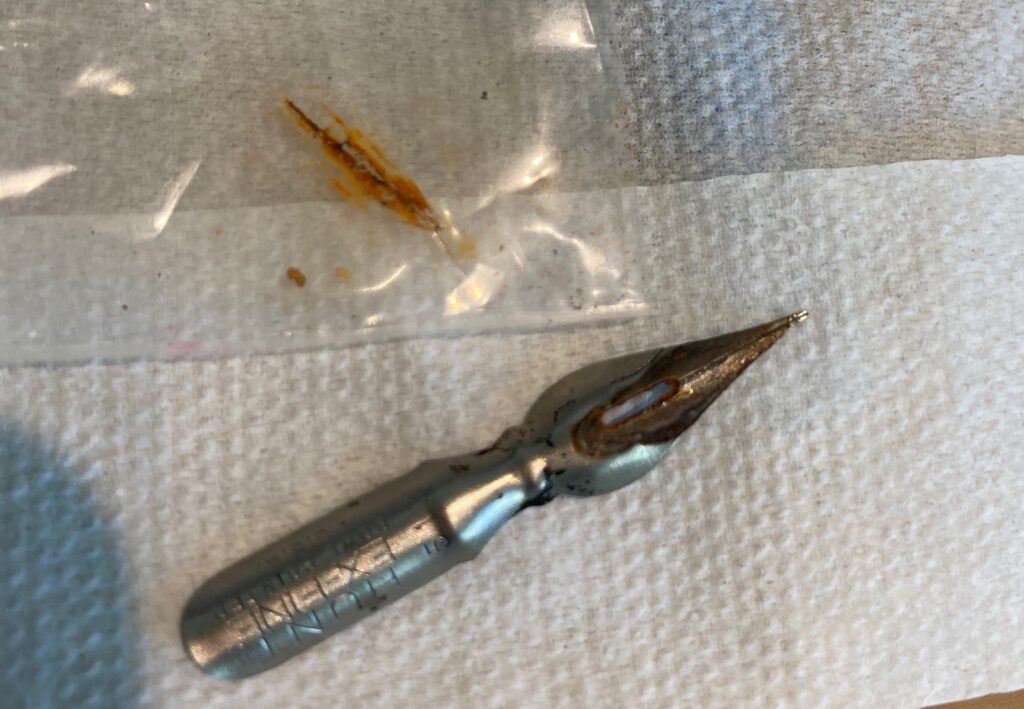
“Rusty nibs! How the internet tells you to care for calligraphy nibs, and what I actually do!” from moonandtide site
So a few options for storing nibs so that they stay bone dry:
store with silica gel
oil them?
storing them separately because rust begets rust
SOOOOO… can I salvage this nib?
There are 2 kinds of rust; surface rust and red rust. AHHHH! It looks red to me but “Nibs are so tiny it can’t be easy to tell the difference, but if your nib is fairly new and has a spot of rust on it, it might just be salvageable. Get an old toothbrush and a pinch of bicarbonate of soda, and rub gently (with a drop of water). Surface rust will clean away, and your nib might be ok to use.”(moonandtide)
Apparently I was NOT supposed to dunk my nib in water to clean it. OOPS! My nib went for a thrash and sink in the water as I happily and naively cleaned it. Kinda like I was cleaning paintbrushes in kindergarten. You all know what I mean right?
Here is a video which can be used as a shaming device for my nib cleaning technique.
Live and learn right? So come back again and check it out next time to see how my nib has survived!
Tracey Humphreys of BCEDAccess was the guest speaker today sharing her knowledge of assistive technology in the classroom with a focus on advocacy for change.

I didn’t know much before about digital accessibility except the addition of subtitles to videos and translation including ASL video in video. I hadn’t considered contrast or describing photos which makes me wonder what else I haven’t considered.
The website Wave – is a web accessibility evaluation tool which provides a breakdown of accessibilty features and shortcomings of chosen online content. See the photo below for a numeracy education website for kids which I assessed using Wave.
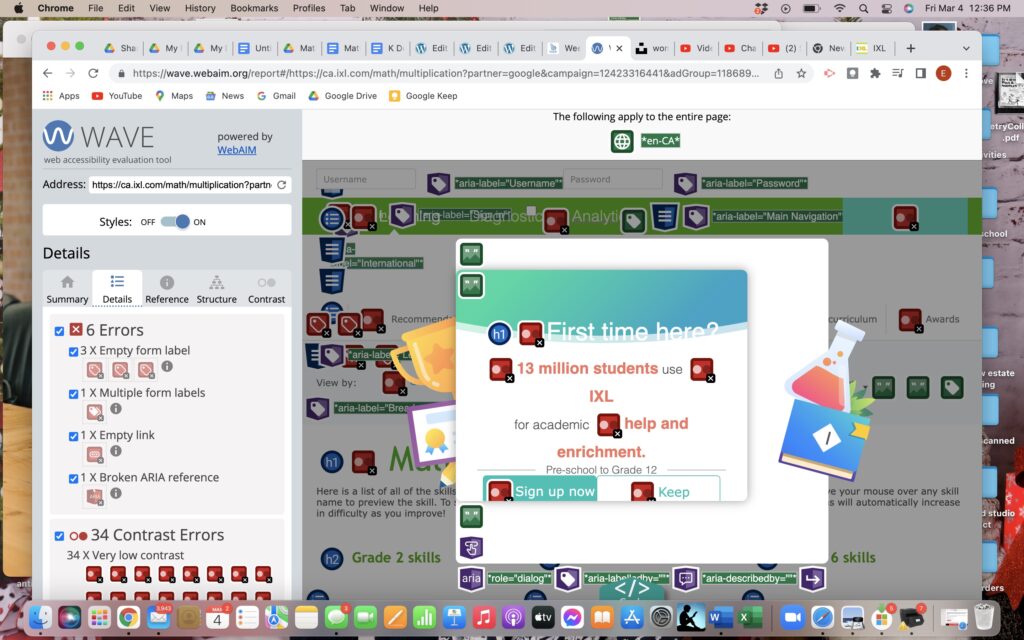
And another for an educational video that shows evaluation of contrast:

I know I have often missed adding Headings as I didn’t know how as well as subtitles and I didn’t consider contrast.
I think many accessibility features are unused because they are unknown and take extra time to include. I bet that often it is assumed that the added accessibility features will only help a few viewers so it’s not worth it; however, these features often help everyone.
A video from BCEDAccess website focusing on inclusive education in BC
I added some accessibility features to my blog post including headings and subtitles on this screencast I did.